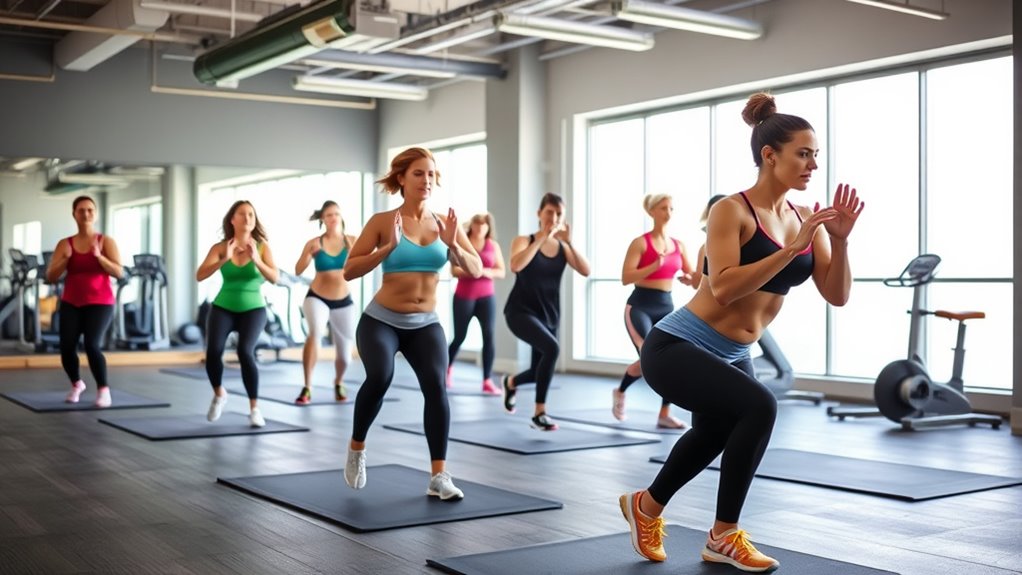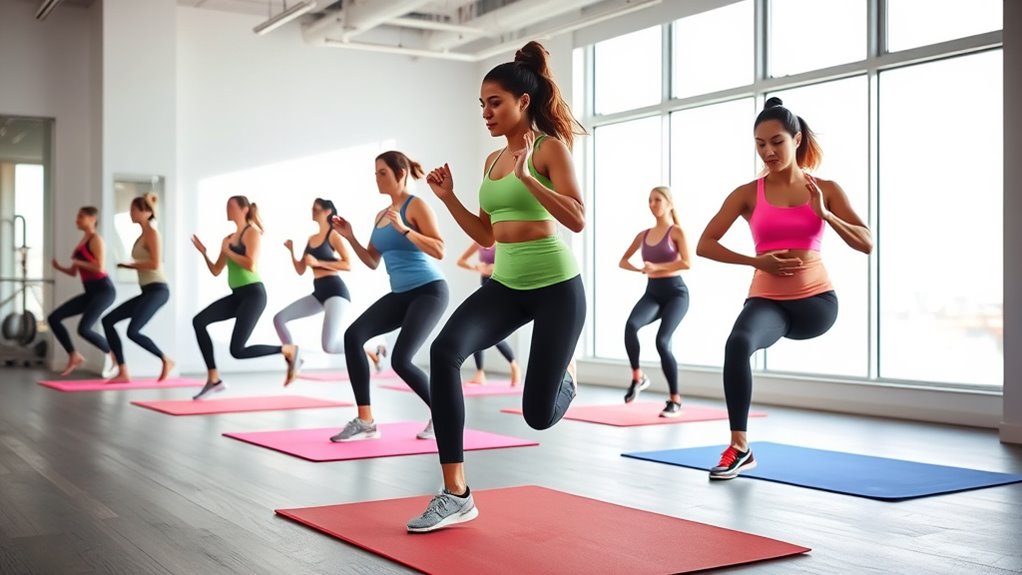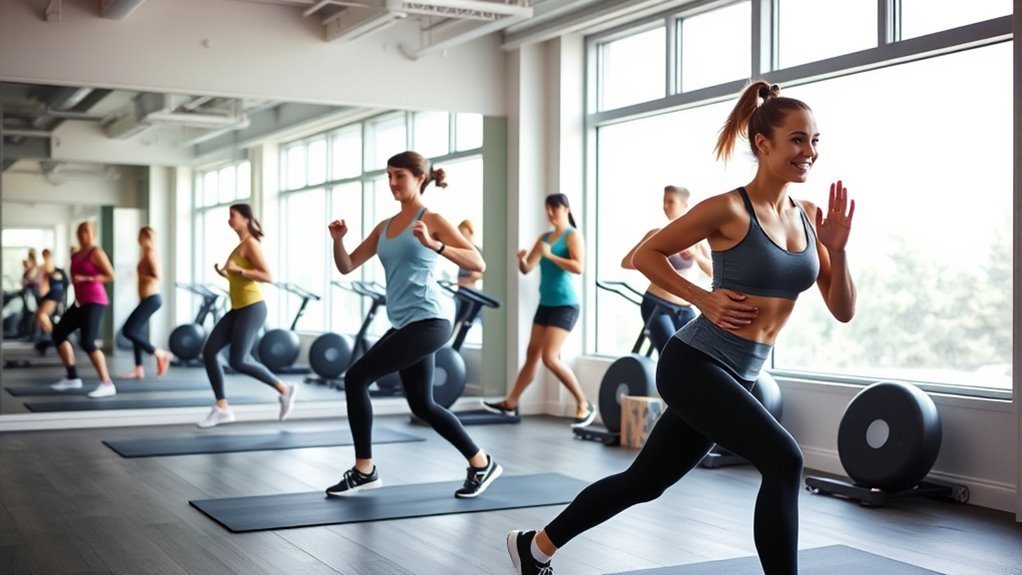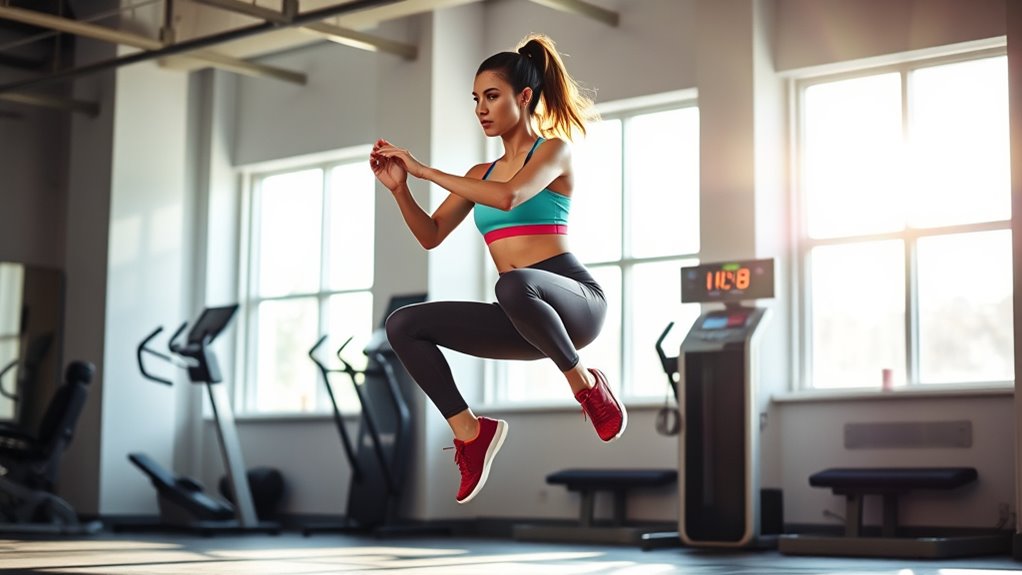Low-impact HIIT provides a joint-friendly way to burn fat efficiently while protecting your joints. By focusing on controlled, low-stress movements like step-ups and planks, you can boost your cardiovascular health, build muscle, and shed calories without risking injury or inflammation. Its quick, effective sessions fit busy schedules and suit all fitness levels, including those recovering from injury or dealing with arthritis. Keep exploring to discover how to design safe, targeted routines that maximize results.
Key Takeaways
- Low-impact HIIT elevates heart rate and burns calories effectively without stressing joints, making it suitable for all fitness levels.
- Incorporates controlled, joint-friendly movements like step-ups and planks to minimize injury risk during high-intensity intervals.
- Alternates short bursts of activity with rest periods to maximize fat burning while protecting joints from overuse.
- Uses modifications such as stepping instead of jumping to maintain intensity without joint impact.
- Supports long-term joint health and mobility by strengthening muscles around joints and promoting flexibility.
Understanding Low-Impact HIIT and Its Benefits

Low-impact HIIT offers an effective way to improve fitness without putting excessive strain on your joints. These workouts are time-efficient, letting you get a full session done faster than traditional steady-state cardio. During each session, your heart rate stays high, boosting cardiovascular health and endurance. You also build muscle strength without risking joint damage, making it suitable for various fitness levels. The intense nature of HIIT burns calories during and after exercise, aiding weight management. Plus, with lower impact, there’s less chance of injury, so you can train more frequently and recover faster. Incorporating knee-friendly exercises can further reduce joint stress while maximizing results. This approach not only enhances physical health but also lifts your mood, reduces stress, and boosts confidence. Additionally, choosing low-impact workout options can help prevent overuse injuries and promote sustainable exercise routines. Overall, low-impact HIIT is a versatile, safe way to achieve fitness goals while safeguarding your joints.
How Low-Impact HIIT Protects Your Joints

Because it minimizes excessive joint stress, low-impact HIIT effectively protects your joints during exercise. It reduces inflammation, similar to low-intensity workouts, helping prevent joint swelling and pain. By choosing exercises that avoid high-impact movements, you lower the risk of joint damage and overstress. Low-impact HIIT also promotes bone health, encouraging bone growth and strengthening joint support over time. Regularly engaging in these workouts can improve mobility and flexibility, key for maintaining healthy joints. Strengthening muscles around your joints provides added support, reducing strain during activity. Using resistance bands, bodyweight exercises, or aquatic options like swimming further decreases joint stress. Proper form and equipment, such as shock-absorbing shoes, enhance safety. This approach guarantees you stay active while safeguarding your joint health. Incorporating proper equipment selection can further optimize your workout safety and effectiveness.
Designing an Effective Low-Impact HIIT Workout

To design an effective low-impact HIIT workout, start by selecting exercises that elevate your heart rate without stressing your joints. Focus on moves like low-impact mountain climbers and lateral runs that keep your joints safe while maintaining intensity. Include movements that target all major muscle groups—legs, glutes, shoulders, back, and core—for balanced conditioning. Incorporate multi-joint exercises, such as squat-to-overhead reaches, to engage multiple muscles at once. Choose controlled, non-jarring motions like plank shoulder taps and crisscross steps to sustain effort without impact. Ensure your exercises can be easily modified in intensity or range of motion to suit your fitness level. A well-rounded workout combines these elements with proper timing, typically 40 seconds of work followed by 20 seconds rest, to maximize fat burn safely. Storing essential oils properly can help maintain your workout environment free of strong or lingering scents. Additionally, incorporating joint-friendly gelato alternatives into your recovery routine can promote muscle relaxation and reduce inflammation. Moreover, paying attention to joint health during your workout can prevent injuries and improve long-term mobility. Regularly practicing proper warm-up and cool-down routines can further enhance joint resilience and overall workout effectiveness. Incorporating lifestyle habits, such as maintaining proper hydration and nutrition, further enhances your joint resilience and overall workout effectiveness.
Equipment and Modifications for Safe Training

Using the right equipment can considerably enhance the safety and effectiveness of your low-impact HIIT workouts. Resistance bands offer variable resistance while reducing joint strain, perfect for controlled strength moves. Dumbbells or kettlebells boost muscle engagement without high-impact motions. Stability balls support core strengthening and balance exercises with gentle joint pressure. A yoga mat cushions your knees, hips, and back during floor work, minimizing stress. Step platforms allow low-impact plyometric modifications by replacing jumps with step-ups. If you prefer no equipment, replace jumping squats with controlled squats on toes or substitute jumping jacks with side steps and arm swings. Supportive gear like wall or chair assistance, foam rollers, and cushioned footwear further ensure safe, joint-friendly workouts. Always prioritize proper form, gradual intensity, and listening to your body. Incorporating local health insights can further optimize your training and recovery strategies. Additionally, understanding mammography guidelines can help tailor your screening schedule to your personal health needs. Paying attention to headphone compatibility can also ensure you stay focused and safe during your workouts, especially if you use music or guided sessions to motivate yourself. Incorporating joint-friendly equipment and modifications can also reduce the risk of injury while maximizing benefits.
Who Can Benefit From Low-Impact HIIT

Low-impact HIIT offers a safe and effective workout option for a wide range of people, regardless of age or fitness level. If you’re recovering from an injury, it helps maintain your fitness without aggravating your condition. Older adults benefit from reduced joint stress, aiding in muscle preservation and bone health. Beginners find it accessible, easing into high-intensity training safely. Those with joint issues, like arthritis, can exercise comfortably and safely. Pregnant women, too, can safely stay active with these workouts. Across ages, low-impact HIIT supports cardiovascular health, mental well-being, and injury prevention. It’s adaptable for different fitness levels, easy to incorporate at home or the gym, and suits busy schedules. This versatility makes it an ideal choice for anyone seeking a joint-friendly, effective fat-burning routine. Additionally, the principles of Growing and Harvesting Chia Seeds like gentle, consistent care can be applied to designing a sustainable exercise routine that promotes long-term health. Incorporating proper recovery strategies, such as adequate rest and nutrition, can further enhance the benefits of low-impact workouts. Understanding the importance of hydration and nutrition can help prevent fatigue and optimize workout results. Incorporating expert guidance can also ensure proper technique and prevent injury during your routine. Recognizing the role of RMDs in retirement planning highlights the importance of proper timing and strategy to avoid penalties and maximize benefits.
Tips to Maximize Fat Burn and Endurance

Maximizing fat burn and endurance during low-impact HIIT hinges on selecting the right exercises and structuring your intervals effectively. Focus on bodyweight moves like mountain climbers, planks, and walking lunges that keep intensity high without stressing your joints. Use modifications, such as stepping instead of jumping, to reduce impact while maintaining challenge. Combine cardio and toning exercises for a balanced workout that promotes fat loss and reshapes your body. Keep your heart rate steady by alternating 30 to 40-second intervals with short 10-second rests, completing multiple rounds for endurance. Start with a warm-up and tailor movements like squats and lunges to your fitness level. Incorporate core exercises to support joints and improve overall stamina, maximizing calorie burn with efficient, joint-friendly moves. Additionally, incorporating appropriate exercise selection ensures you stay safe while achieving effective results.
Frequently Asked Questions
Can Low-Impact HIIT Replace Traditional High-Impact Workouts Entirely?
You might wonder if low-impact workouts can completely replace traditional high-impact exercises. The truth is, low-impact HIIT can often serve as an effective alternative, especially if you have joint issues or need a gentler approach. It offers similar cardiovascular and fat-burning benefits while reducing injury risk. However, for maximum muscle engagement or high-intensity strength gains, combining both types may be more beneficial.
How Often Should I Do Low-Impact HIIT Workouts per Week?
You’re wondering how often you should do low-impact HIIT workouts each week. The answer depends on your fitness level and goals. Generally, aiming for 2-3 sessions keeps you progressing without risking overtraining or injury. Remember, 20-30 minutes per session with proper recovery days in between is ideal. Stick to this, listen to your body, and you’ll find the perfect balance to burn fat while protecting your joints.
Is Low-Impact HIIT Effective for Rapid Weight Loss?
You wonder if low-impact HIIT helps with rapid weight loss. It’s effective because it burns calories efficiently in shorter sessions, comparable to longer workouts. Plus, the high-intensity intervals boost your metabolism and increase post-exercise calorie burn. By combining this with a healthy diet, you can see noticeable results quickly. Just remember, consistency and proper recovery are key to sustaining weight loss and avoiding injury.
Are There Specific Injuries or Conditions That Contraindicate Low-Impact HIIT?
Did you know that about 8% of exercise-related injuries involve joint issues? When it comes to contraindications, you should avoid low-impact HIIT if you have severe osteoarthritis, recent joint surgery, or chronic injuries like tendinopathy. Conditions such as unstable cardiovascular disease, uncontrolled diabetes, or severe balance impairments also make this exercise risky. Always consult your healthcare provider before starting, especially if you have any of these injuries or health issues.
How Can Beginners Safely Progress in Low-Impact HIIT Routines?
To progress safely in low-impact HIIT routines, start with short, manageable intervals and focus on perfecting your form. As you feel comfortable, gradually increase the duration or number of intervals by small amounts, keeping movements controlled. Listen to your body, ensuring you’re not overexerting or experiencing discomfort. Incorporate rest days, use supportive gear, and perform exercises on softer surfaces to protect your joints while building endurance.
Conclusion
Incorporating low-impact HIIT into your routine can boost fat burning without stressing your joints. Did you know that you can burn up to 25% more calories in just 20 minutes of HIIT compared to steady-state cardio? By choosing joint-friendly moves, you stay active longer and reduce injury risk. So, whether you’re recovering or just want a safer workout, low-impact HIIT keeps you moving efficiently—without sacrificing your joints or progress.









